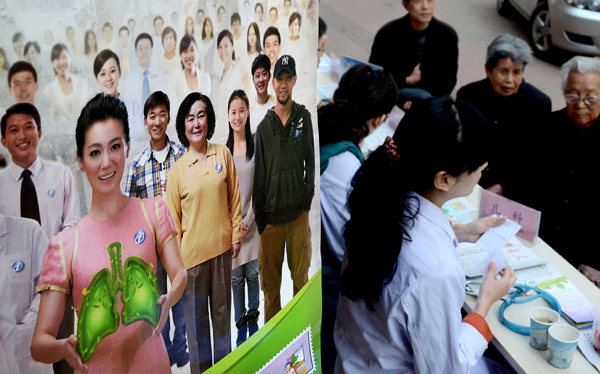
 |
|
Medical staff from hospitals in Zhengzhou, Henan province, promote prevention and control of tuberculosis to local residents. China has made huge progress in the fight against TB, but the disease continues to pose a threat to public health. [Photo/Xinhua] |
Although the global battle against tuberculosis has largely been successful, the disease still poses a serious threat in China, especially for poor people, and will only be entirely eradicated through greater financial protection for patients and the elimination of social discrimination, according to experts speaking ahead of World Tuberculosis Day, which falls on March 24.
A report published by the World Health Organization said that in the past 20 years China has made great progress in the control and prevention of TB, which has resulted in a significant decline in the disease. Meanwhile, the National Health and Family Planning Commission, China's top health authority, said the number of new cases has declined steadily in the past two decades.
Last year, 889,381 new cases were reported on the Chinese mainland, a decline of 1.7 percent from 2013, and 2,240 people died, the commission said.
However, the commission's figures show that TB still ranks second on a list of highly infectious diseases in terms of the number of cases reported and resultant deaths.
"Tuberculosis remains the No 1 one public health threat from an infectious disease in China," Bernhard Schwartlander, WHO representative in China, said. "There are still an estimated 1 million new cases of TB in China every year. Disturbingly, the highest rate of tuberculosis infection is among the poor."
WHO statistics show that 9 million new cases of TB are reported globally every year, leading to about 1.5 million deaths.
As an airborne disease, TB can be transmitted by coughs, sneezes, contact with an infected person's saliva and even through conversation, which make prevention more difficult than for some other infectious diseases, Schwartlander said.
A disease of poverty
According to Fabio Scano, WHO coordinator for disease control, about 82 percent of TB patients in China earn less than the national average wage. "Tuberculosis in China is a disease of poverty. The high cost of treatment and the need to take medication over an extended period of time, in particular for patients with multi-drug resistant TB (usually called MDR-TB), makes treatment less viable for the poor."
MDR-TB, a particularly dangerous form of the disease, occurs when the bacilli grow resistant to Isoniazid and Rifampicin, the two most-powerful anti-TB drugs, which is usually the result of improper treatment during the early stage of the infection.
In 2011 just 3 percent of 100,000 new MDR-TB cases were diagnosed and reported, and only 2 percent of patients received the standard treatment, according to the Chinese Center for Disease Control and Prevention, which said, "MDR-TB poses a serious problem to TB prevention and control in China."
Chen Mingting, deputy head of the National Center for Tuberculosis Control and Prevention, said: "The proportion of MDR-TB patients that received standardized treatment rose to 7.7 percent last year." He added that rapid response is vital. "There are no effective vaccines for TB, so speedy diagnosis is especially important for the prevention and control of the disease," he said.
In recent years, China has intensified research into the diagnosis of MDR-TB, and has made good progress. New molecular testing methods for MDR-TB have reduced the time lag between the collection of "resistance test" specimens and the start of treatment by 90 percent, from an average 139 days to just 14, Chen said.
The new method, published in the journal Lancet Global Health last week, greatly facilitates testing for MDR-TB and will bring huge benefits to patients, he said.
"In addition to rapid diagnosis and standardized treatment, improved disease management is the key to curing patients with MDR-TB," he said.
According to Chen, the optimum treatment period for people with MDR-TB is 18 to 24 months, but many patients-especially migrant workers, one of the largest MDR-TB groups-fail to complete the course: "The patients receive standardized treatment at hospitals and are supposed to continue to take medication under the guidance of doctors after being discharged. But in reality they may not take the medication as required, and sometimes the doctors lose contact with patients because they have moved to other cities and regions."
The high cost is one of the reasons that very few MDR-TB patients receive standardized treatment, Chen said. A full course costs about 30,000 yuan ($4,800), according to the WHO, a sum that puts it out of the range of most migrant workers and others in low-paid jobs. To put that figure in context, per capita GDP in China was 47,000 yuan last year.
"Some patients have received treatment intermittently for more than 10 years, but still haven't been cured," Chen said. "Imagine how much they have paid for their treatment over the years."
He said the highly infectious nature of MDR-TB, coupled with the ease of transmission, mean that in some cases entire families have the disease. "We've seen this phenomenon in rural families living in extreme poverty," he said.








